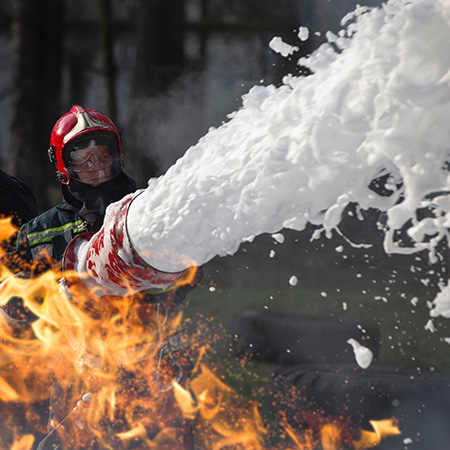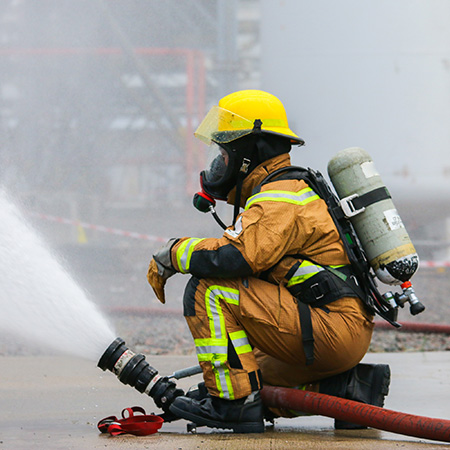Thousands of military personnel and firefighters across the nation have used or been exposed to AFFF (Aqueous Firefighting Foam or Aqueous Film Forming Foam) in the course of their daily work duties. These individuals may be at a greater risk of developing numerous types of cancers. In addition, people who live around military bases and airports risk exposure to the dangerous chemicals in AFFF. Both employers who used the foam and manufacturers who produced it can be held liable for the injuries and illnesses that are linked to this chemical.
Once AFFF is released into the environment, the foam and its toxins contaminate the surrounding soil, as well as any lakes, streams, or groundwater. Anyone who has been exposed to this product is eligible to pursue a firefighting foam lawsuit. A law firm specializing in personal injury claims and with experience in handling these types of cases can be critical to winning the compensation needed to cover the enormous medical costs that can result.

What is AFFF Firefighting Foam and How Does It Work?
AFFF is a synthetic, water-based surfactant. This means it is easily distributed via hoses, like water, and has chemicals in it that cause it to stick to any surface. Because of these qualities, it is extremely good at controlling and suppressing Class B fires, which are fires that involve flammable liquids like gasoline or petroleum. AFFF has been especially useful in smothering fires in environments such as airports and on military bases, where jet fuel fires can be difficult to extinguish. Additionally, civilian fire departments use this material in both their training exercises and in actual fire fighting.
Major chemical manufacturers such as DuPont, Chemguard, Tyco, and 3M Company have produced and sold AFFF since the 1960s. Allegations in lawsuits have argued that these companies used toxic chemicals to make firefighting foam, such as perfluorooctanoic acid (PFOA) and perfluorooctanesulfonic acid (PFOS). These agents belong to a chemical family called per- and polyfluoroalkyl substances (PFAS) and are dangerous enough that the Environmental Protection Agency (EPA) has developed a roadmap to address the use of these chemicals.
PFAS in AFFF – What Makes Them Dangerous?
The man-made chemicals in the PFAS group have been included in a wide variety of products for the past 80 years and are considered C-8 chemicals. This name describes their very strong 8-carbon atom chain, which means they take an extremely long time to break down in nature and especially in the human body. They are often called “forever chemicals” because they do not dilute, degrade, or disappear over time. They have been found to accumulate in the tissues of animals and humans, as well as persist in sources of groundwater and drinking water.
Because they do not go away, AFFF and other products that use PFAS chemicals pose risks to entire communities, not just to those individuals who are exposed to the foam in their workplace. People who live near airports or military bases are vulnerable through contaminated municipal drinking water systems, as well as employees in those locations who do not fight fires but simply work where AFFF is used.
The EPA, Centers for Disease Control and Prevention (CDC), and the American Cancer Society (ACS) have all issued reports linking PFAS chemicals to cancer in first responders, particularly firefighters. Individuals who have served in the military on bases and locations where AFFF and other products containing PFAS were used are at greater risk of various types of cancers, says the US Department of Veteran Affairs. Despite the warnings from these agencies, manufacturers are still selling these chemicals, and they are still in use by firefighting departments.

Illnesses Linked to AFFF
When you or a loved one is exposed to AFFF products, the toxic chemicals commonly accumulate in the kidneys, liver, and blood. Toxicological research has shown that exposure can also cause potential reproductive, developmental, and systemic effects in animals that have been exposed. Many illnesses and health risks have been noted when people are in contact with firefighting foam, such as dysfunctional thyroid, delayed puberty, increased cholesterol, osteoarthritis, and problems with the immune system. The effect these agents have on human health can be devastating.
Further medical conditions that are believed to be related to high levels of exposure to PFOS or PFOA chemicals include cardiovascular issues, skeletal problems, and abnormalities in fetal development. They are also considered at risk for causing ulcerative colitis and preeclampsia. Because these toxic chemicals remain in the human body for so long and can accumulate, they have tremendous potential for causing injurious health effects.
The PFAS chemical family has been linked through epidemiological evidence to a number of cancers in humans, and the International Agency for Research on Cancer (IARC) has designated PFAS chemicals as possible human carcinogens. Some common cancers that are linked to PFAS and PFOA exposure include:
- Testicular cancer
- Pancreatic cancer
- Thyroid cancer
- Bladder cancer
- Kidney or renal cancer
- Breast cancer
- Colorectal cancer (colon and/or rectal cancer)
- Leukemia
- Liver cancer
- Lymphoma
- Prostate cancer
The International Association of Fire Fighters (IAFF) has reported that of the career firefighters who suffered line-of-duty deaths between 2002 and 2019, 66% of them died from cancer. Firefighters show a 9% higher chance of a cancer diagnosis and a 14% higher risk of dying from some type of cancer than the general population in the US, according to research by the CDC.
What Damages Can I Seek in a Firefighting Foam Lawsuit?
A firefighting foam lawsuit is usually filed as either personal injury or as a product liability claim, depending on the named defendant. Personal injury would seek to recover damages from an employer or individuals who caused the exposure, whereas a product liability case would name the AFFF manufacturer as the liable party. Regardless of how a plaintiff chooses to proceed, the assistance of competent attorneys and legal professionals is critical to ensuring successful litigation.
Maintaining detailed documentation and gathering relevant evidence are key to the foundation of a firefighting foam lawsuit. The law firm will consult with the plaintiff and assist in compiling all available receipts and records to calculate the list of damages to seek. They will also develop a request for fair and appropriate compensation needed for the victim and their family to recover from injury or illness. In the most catastrophic cases, a lawyer will assist the loved ones in filing a wrongful death suit.
Damages you can seek in a firefighting foam lawsuit include:
- Medical expenses
- Hospital costs
- Therapy bills
- Loss of enjoyment of life
- Loss of companionship
- Loss of income or earning potential
- Disability
- Mental anguish
- Pain and suffering
- Paralysis or other medical ailments
- Memory loss
- Loss of inheritance potential for the family
Louisiana Civil Code Section 3492 states that claimants have one year to file a personal injury or other lawsuit against those who have wronged them. However, the discovery rule can apply in cases where a person was not aware that an injury-causing event occurred, such as with exposure to PFAS chemicals. In situations like these, the statute of limitations begins when the cause of the person’s illness or injuries has been established. The discovery rule can also apply in wrongful death cases or those where a conclusive cause of death cannot be determined. A skilled lawyer can provide guidance on how this rule applies to any given case.
Get Help With Your AFFF Firefighting Foam Lawsuit Today
If you or a loved one have been exposed to AFFF firefighting foam, contact the experienced New Orleans law firm of Allan Berger & Associates. Our professional team will work tirelessly to ensure you receive justice. Contact us for a free consultation today online or by phone at (504) 526-2222.
Injured?
Get a Case Evaluation Now.
What People Say
“Allan Berger & Associates was there for me from Day 1 and can’t thank Andrew and Miss Melanie for all of their help. I wish I had them around the house!”
– Dolores A.
“Allan and Andrew fought for every dollar for me and I will be forever grateful. They aren’t just my attorneys, they are family.”
– Charles P.
I am so grateful to you for all you did to resolve my case. You were wonderful and made me feel so comfortable and calm. I could not have asked for a better attorney. God Bless.”
– Darlene C.
“Calling Allan Berger & Associates after my car accident was a blessing. I don’t know where I’d be without their help, and I’d recommend the firm to anyone else!”
– Tarra R.
“Thank you for your sensitivity and professionalism in your awesome handling of my case. First class representation and you treated me like I was a family member. Even though my case settled I’d like to stop by the office just to say hi.”
– Donna C.




